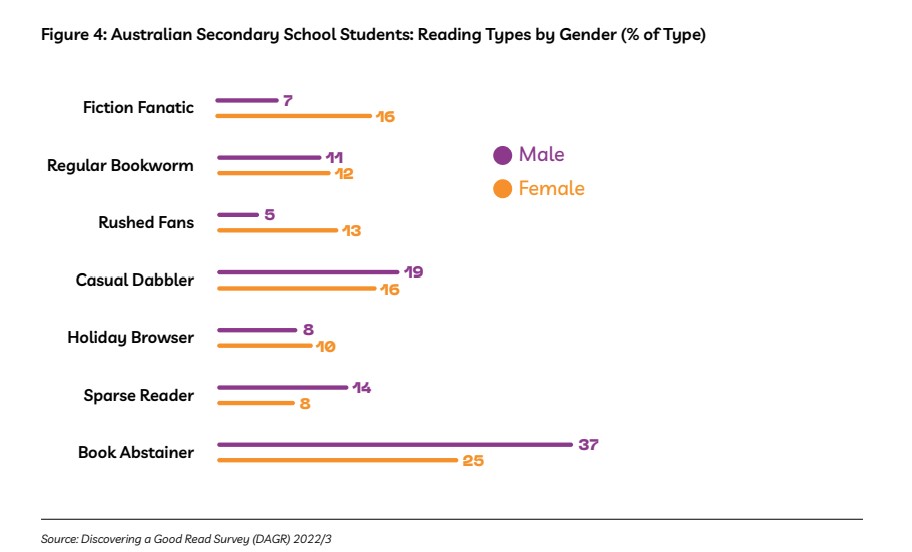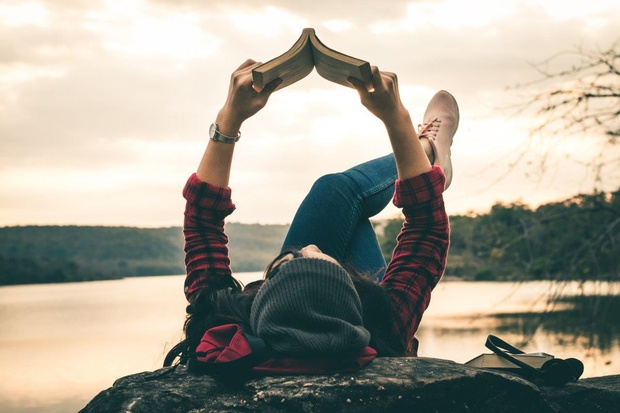That’s according to a new report produced by a team of researchers headed by Deakin University’s Associate Professor Leonie Rutherford, whose survey of more than 13,000 Australian secondary school students focused on teens’ voluntary reading habits, specifically excluding homework or school-assigned reading.
Rutherford, who works in Deakin’s School of Communication and Creative Arts, says many of the findings were as expected, however the fact that teens would sooner flick through the pages of a physical novel than listen to an audiobook or read on their phone or tablet, was something of a surprise.
“The research was really just about discovering if reading is still out there and if it’s still important in an age where digital advancements have just changed the way we do so many things,” Rutherford says.
“[We found] the really good, really passionate readers read e-readers as well [as hard copy books] … and there are different reasons for that. E-readers are obviously quite convenient, [because they’re digital] you can take a lot of books around with you in your pocket, especially for holidays and so on.”
She says there’s a range of complex reasons for why it appears that the popularity of print versions of books remains high.
“People still get a lot of books as presents, and another source for getting them is bookstores, or what’s at home,” she explains.
“There are printed books in the school library, as well, but there’s also what’s called ‘haptics’, the touch, and the smell, and the feel of the printed book – some people really like that, they like the fact that they can colour code and sit on their shelves, and it’s an object they can own.
“So it could be partly access and partly the fact that we are physical embodied creatures, and we like the things we can touch and feel and smell and look at the beauty of covers in some cases.”
Gender appears to play a role in reading habits (see Figure 4 below), with females generally engaging more with reading than males.
As would be assumed, fiction genres such as fantasy, mystery and crime, and dystopian plots are also among teens’ favourite picks.
“Overwhelmingly, fiction was preferable, as we were asking about recreational reading that you do for pleasure,” Rutherford says.
“Funnily enough, those who said they prefer to read non-fiction, said they don’t enjoy the reading as much as the people who read fiction.
“I’m not surprised really, because it’s a story, it’s imaginative escape…”

“Our research sought to understand the reading habits of secondary students so we could find ways to better foster a love of reading in young people. Teens today have more distractions than ever than to sit down with a good book,” researcher, writer and analyst Associate Professor Leonie Rutherford says.
One issue that could explain low rates of reading for pleasure might be the growing inequity in access to well-resourced school libraries, particularly between public and private schools, and metro and regional and remote areas.
Some of the teacher-librarians spoken to by Rutherford said that they didn’t believe there was good quality non-fiction material available for older readers in their school.
“That came up in our interviews – that there was good non-fiction for younger readers but not for older readers. Because we asked a set of questions about gaps, things like ‘how good is your school library?’ and ‘What would you like to have more of?’, what came up quite a bit was that there was not really enough funny literature and not enough good non-fiction for older readers.”
More than a third of surveyed students didn’t engage with articles, blogs, magazines, comics or newspapers, while factors that influenced their reading habits varied, with almost two thirds (61 per cent) reading other books by an author they like, more than half (57 per cent) receiving recommendations from friends and 55 per cent reading the book of a movie, TV show or game they like.
Interestingly, in terms of engagement with books, their reading choices were less influenced by their school or their postcode than their parents and friends.
“I was a bit surprised that region and school type didn’t make a bigger difference, because you’re paying a lot of money to send your kid to an independent school, aren’t you?”
With almost three-in-10 Year 7-12 students saying they do not read in their spare time, there appears to be an urgent need to foster reading among youth.
Research suggests reading for pleasure can lead to better academic achievement, higher levels of wellbeing and better employment outcomes after finishing school.
“... there are some who suggest that for the first three years you’re learning to read and then you’re reading to learn...,” Rutherford says.
“Reading is where you build vocabulary, terms that you can use in the world, and knowledge of other things, so if you stop doing it when you can read, you’re not adding to what you know, and you’re not adding to the words that you know, that you can use and employ in another context.
“So, it is important to keep it up because school reading can be subject-bound, whereas imaginative reading, or even non-fiction reading, include words you haven’t heard before.
“I still have one or two words, I have to look up. And even though I know that I’ve read them before, and I know what they mean, but because I got them later in life, they don’t seem to stick.”

The study of more than 13,000 Year 7-12s showed 29 per cent don’t read at all outside school work, 17 per cent read less than once a week and only 15 per cent read daily.
Rutherford says she was encouraged by the fact that a lot of students said they thought they’d be reading more in 10 years-time than they are now.
“I was surprised, however, as I said earlier, that region and school type didn’t make a difference, that gender was the key thing.
“And I was surprised that more people didn’t use social media to find books. Because even avid readers use social media. So I thought there’d be more of that.”
With almost a third of Australian children across Years 3, 5, 7 and 9 failing to meet new proficiency standards for literacy in last year’s NAPLAN tests, it’s clear that reading rates – in and out of schools – need to rise.
Encouragingly, more than 16,000 children and young people across Victoria set a new reading record in this year’s Big Summer Read – but do programs like this and others in schools really help to fashion and nurture a love of reading?
“Obviously, we didn’t do an intervention study or anything similar, but what we got was people telling us about best practice, and what’s worked for them,” Rutherford offers.
“In the home, if you make books available, and you make a time for reading available, where if it’s only 10 minutes, maybe before dinner, when homework’s done, you’ve got a nice little nook, the TV’s not on, and everybody sits down and reads a book ... And I know you’re probably reading the subtext ‘privilege, privilege, privilege’ here. But that’s been shown to work.
On the school front, she says while some have brought in daily read-what-you-like programs, there’s not many.
“There’s one [school] here in Victoria that we found out about when we did our pilot, with a program that was driven by a passionate English teacher,” she says.
“Every seventh period, it didn’t matter what the subject was, everybody – the teacher, the whole school – would sit down and read a book of their choosing.”

At an independent girls school in New South Wales, Queenwood, they’re getting even more creative and literally ‘stealing’ five minutes from every period.
“They had to get the school leadership on board and show them research that proved this thing helped,” Rutherford says.
“So rather than giving up 15 minutes of a lesson, which is pretty hard when you’ve got to get through the curriculum, they ‘stole’ five minutes from everybody’s lessons.
“So for 20 minutes at 12 o’clock, the whole school sat down and read. They put a culture in that was peer moderated a lot of the time, and it was really well implemented.
“Both those schools have noticed upticks in their reading culture, in their NAPLAN results, basically through doing that.”
To read the full report, titled Discovering a Good Read: Exploring Book Discovery and Reading for Pleasure Among Australian Teens click here.
















